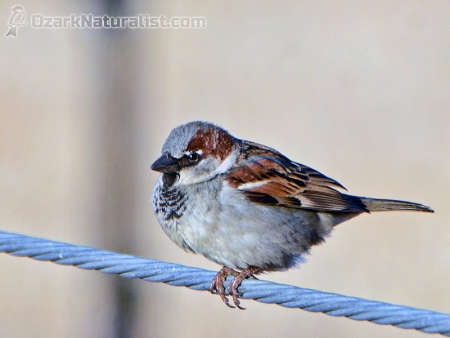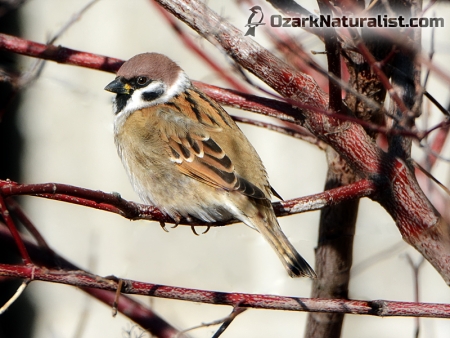Everyone is familiar with House Sparrows, right? Even non-birds must be aware of them since the pestiferous little bastards are everywhere.
North America’s first encounter with this species took place in Brooklyn in the early 1850s. A number of birds were released in the hope that they would stop an outbreak of linden moth caterpillars. But intentionally introducing these bird led to unintentional consequences. Oh, were there consequences.
Accustomed to living in proximity to humans, adaptable, and aggressive, those first birds thrived and spread. Supplemented by later releases in San Francisco and Salt Lake City, they soon occupied the entire continent excluding northern-most Canada.
But we have another introduced sparrow, one that is probably unknown outside the birder’s circle. This bird, the Eurasian Tree Sparrow, was introduced in April 1870. Twelve birds (or twenty, depending on where you get your information) from Germany were released in St. Louis’ Lafayette Park. This was part of a misguided effort improve the native bird life and provide a “familiar face” to the large immigrant population, homesick for the old country.
Despite being much less aggressive than the House Sparrow, those twelve birds still managed to establish a breeding population, albeit on a much smaller scale. There are now about 15,000 of them, mostly in the St. Louis area but also spreading north along the Mississippi River into Iowa and Illinois. Ironically, when the House Sparrow reached St. Louis, they drove their more timid cousins from the downtown area and they now occupy mainly residential and rural areas.
House Sparrows are the obnoxious neighbors with the loud truck, louder music, and drunken parties. The ones that take a piss on your prize roses. Meanwhile, Eurasian Tree Sparrows are the quiet, polite neighbors whose presence you barely notice. Unlike the House Sparrow, their environmental impacts have been minimal, causing little or no damage to native bird populations. For those reasons, I can accept them alongside our native birds, while I detest House Sparrows.
I photographed both birds pictured here at the Riverlands Migratory Bird Sanctuary in St. Charles, north of St. Louis. The first photo is the very first frame of a Eurasian Tree Sparrow I ever shot and I really like the image. The bird was next to the Riverlands’ Visitor Center where I found him under brutal conditions.
It was 10°, but the wind chill was 20 degrees colder and even dressed warmly, I could only endure for 10-15 minutes before returning to the car. The wind and cold made my eyes water, which ran down my face before freezing in my mustache, along with the condensation from my breath. This despite wearing sunglasses and a balaclava. It was fantastic weather if you were a Polar Bear or just like freezing your noogies off, and I’m in no hurry to repeat the experience!
References:
- Jackson, Jim. “The Eurasian Tree Sparrow.” Missouri Conservationist. May 01, 2003. Accessed March 11, 2018.
- Korotev, Randy. “Where to Find a Eurasian Tree Sparrow in the Saint Louis Area.” Where to Find a Eurasian Tree Sparrow in St. Louis. February 26, 2011. Accessed March 11, 2018.
- Widmann, Otto (1909) Summer Birds of Shaw’s Garden, Twentieth Annual Report of the Missouri Botanical Garden, 59–62.


